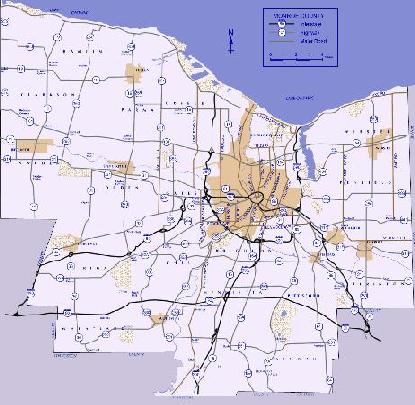Home | People | Projects | Publications | Resources
TRIPS Home | TRIPS Architecture | TRIPS Movies | TRIPS Domains | TRAINS vs. TRIPS
|
Introduction
The TRIPS-911 system engages in conversation in a small 911 setting in which new emergencies arise and the user collaborates with the system to dispatch and manage the available resources (e.g. a few ambulances, fire trucks). One of the key motivations in designing this domain was to push our TRIPS testbed with work on mixed-initiative dialogue. Because the system can be notified of emergencies and progress reports from the field, there are many situations where the system has to decide whether to take the initiative, possibly interrupting a conversation that is ongoing.

Map of Monroe County, NY used in TRIPS-911 domain
Dialogue management and problem solving
TRIPS is designed as a set of loosely-coupled modules that exchange information by passing KQML messages. At the core of the TRIPS architecture are the modules responsible for maintaining the conversation with the user and helping to achieve user and system objectives. The responsibilities are divided between conversation management and problem solving. The conversation management components combine the interpreted communicative acts from the input with the discourse context in order to determine the intended speech acts. They then plan the system's utterances to continue the conversation. The problem-solving components control the overall activity of the system, including managing the interactive problem solving, and planning and executing domain actions. More specifically, they help resolve ambiguities by applying plan recognition techniques and they coordinate the invocation of the specialized reasoners that provide solutions in service of user and system objectives. More information on the TRIPS architecture can be found in Allen et al 2000 and Ferguson and Allen 1998.
The 911 domain
The 911 domain is designed to encourage collaborative problem-solving and mixed-initiative interaction, and so push the state-of-the-art in dialogue systems. The user acts as a kind of emergency dispatcher, cooperating with the system to dynamically allocate resources to and make plans for solving problems as they arise in the world. The setting, Monroe County, NY, is considerably more complex than our previous domains (e.g. Pacifica, TRAINS) and raises new issues in knowledge representation and reference. Emergencies include requests for medical assistance, car accidents, civil disorder, and larger problems such as flooding and snow storms. Resources at the user's disposal may include road crews, electric crews, ambulances, police units and helicopters. Some of the increase in mixed-initiative interaction comes from giving the system more knowledge of the tasks being solved. Some comes from the fact that the solution to one problem may conflict with the solution to another, either because of scheduling conflicts, scarce resources, or aspects of the physical world (e.g. an ambulance can't go down a road that has not been plowed). The range of tasks and complexity of the world allow for problem solving at different levels of granularity, making it possible for the system to take as much control over the task as the user permits.
Important contributions
While a number of robust dialogue systems have been built in recent years, they have generally operated in domains that require little if any reasoning. Rather, the task is hard-coded into the system operation. One of the major goals of the TRIPS project has been to develop dialogue models and system architectures that support conversational interaction in domains where complex reasoning systems are required. One goal has been to build a fairly generic model in which different domains can be specified fairly easily. On this front, we are seeing some success as we have now constructed versions of TRIPS in three different domains, and TRIPS-911 will be the fourth. In developing the system for new domains, the bulk of the work has been in system enhancements rather than in developing the domain models. The TRIPS-911 domain has forced a rethinking of the relationship between dialogue-management, problem-solving, the system's own goal-pursuit and generation. The new architecture is designed to support research into mixed-initiative interactions, incremental generation of content (in which the user might intervene before the system completes all it has to say), rich reference resolution models, and the introduction of plan monitoring and plan repair into the suite of plan management operations supported. More complex domains mean even more complex dialogues. The complexity arises from many factors. First, more complex dialogues will involve topic progression, development and resumption, and more complex referential phenomena. On the problem solving front, there will be more complex corrections, elaborations and modifications -- forcing us to develop richer discourse models. In addition, the complexity of the domain demonstrates a need for better grounding behavior and a need for incremental dialogue-based generation. We have by no means solved these problems. Rather, we are building a rich testbed, designing and implementing a plausible architecture, and constructing an initial system to demonstrate basic capabilities in each of the problem areas.
Limitations
TRIPS-911 is a first attempt at handling a domain of this complexity. There are many capabilities that people have in dialog situations that are beyond the system's current capabilities. Some of the most important are:
This document was taken from James Allen, Donna Byron, Dave Costello, Myrosia Dzikovska, George Ferguson, Lucian Galescu, and Amanda Stent, "TRIPS-911 System Demonstration", Proceedings of the NAACL/ANLP 2000 Workshop on Conversational Systems, May 2000, Seattle, WA. |